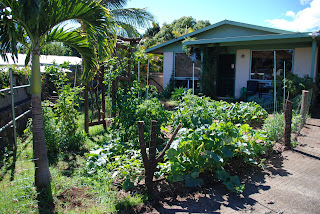I love animals, but never thought much of birds until I lived up in Olinda where the owner had a huge chicken coop. Long story short, I got hooked. Who knew they could be so personable?
I think it's worth raising your chickens from babies even though it costs a bit in feed before they will start to lay (about 6 months in). Get them from someone who is going to give you healthy, strong birds. D's first chickens were wild birds the neighbors trapped for him, but the eggs never got very large, and the leader of the pack was REALLY mean. She killed my dove - stuck my dove in the neck with her beak! Of course, in the wild, chickens eat doves - so she was only doing what she had learned in the wild to survive.
It was hard on me just the same.
Anyway, it's much more fun to have friendly birds greet you at the door in the morning and eat out of your hand. The eggs are much bigger, so it's worth it on that level too (we paid $5 a piece for pure bred chicks).
But this is the story of our first group of babies - the ones D can't talk about.
I went to Vicki and Chris in Puklani to pick out 8 beauties (Not sure if she wants me to publish her #, so if you are interested in getting some, let me know and I'll get it for you). I put them in a large dog kennel because they were so tiny. I encouraged Daren to spend time with them so they would be bonded to him. The first couple weeks, he sat diligently on the front porch holding each one in turn, every day.
D build the girls a nice coop and after a couple weeks of being kept in the dog kennel on a heating pad, they were ready to fly, literally. So we tucked them into the new coop.
A few days later, we awoke to disaster - 6 of the 8 babies were gone - no where in sight. We knew the dogs couldn't have gotten in - so we were baffled as to what had happened until we found a small mongoose size hole dug under the fence.
We were both devastated. Only Edie and Mo survived. We have Mo today, though Edie turned out to be an 'Ed', so when he began to crow, we returned him to the breeder after she promised he would go to a good home.
We got a new crew from Vicki who was very sympathetic, but Daren didn't sit on the porch with them. I know he likes the new girls, but I think the loss weighed too heavy on his heart to get bonded as he did the first time around.
Here's our homage to our first chicken crew:
"Edie" - later known to be "Ed" - won the cutest portrait award.
(Americana - they lay blue and/or green eggs)
(Americana - they lay blue and/or green eggs)
Georgie, so named for her mustache (Barred Plymouth Rock)
Hen - short for Henrietta (Barred Plymouth Rock)
Mirabella - so named because when she grew up, her feathers would have been iridescent, like a fairy.
(Black Sex Link)
'Poo' - short for Pualani, which means "heavenly flower" in Hawaiin.
This loss may have been the hardest for D
This loss may have been the hardest for D
(Buff Orpington)
Rosie - so named for her color
(Road Island Red)
Daisy - my little sweetie. I loved them all, but Daisy and I had a special bond
:(
(Buff Orpington)
And Mo, our sole survivor, so named because as a baby, we could tell her apart from her sister by the darker red line of fluff on her head that looked like a Mohawk.
(Road Island Red)
Lesson: Until your babies are 10 weeks or older, you are at risk of loosing them to Mongoose.
Mongoose are very good diggers. Unless you run the edges of the cage into the ground at least a foot (which is still no guarentee), or pour cement to secure the bottom, then keep them inside the house or in a tightly secured cage to avoid setting up a mongoose smorgasbord. After our loss, we dug a foot and a half down, ran chicken wire into the ground at an angle, and reinforced it with buried rocks as well as topical stones around the perimeter.
Mongoose are very good diggers. Unless you run the edges of the cage into the ground at least a foot (which is still no guarentee), or pour cement to secure the bottom, then keep them inside the house or in a tightly secured cage to avoid setting up a mongoose smorgasbord. After our loss, we dug a foot and a half down, ran chicken wire into the ground at an angle, and reinforced it with buried rocks as well as topical stones around the perimeter.


















